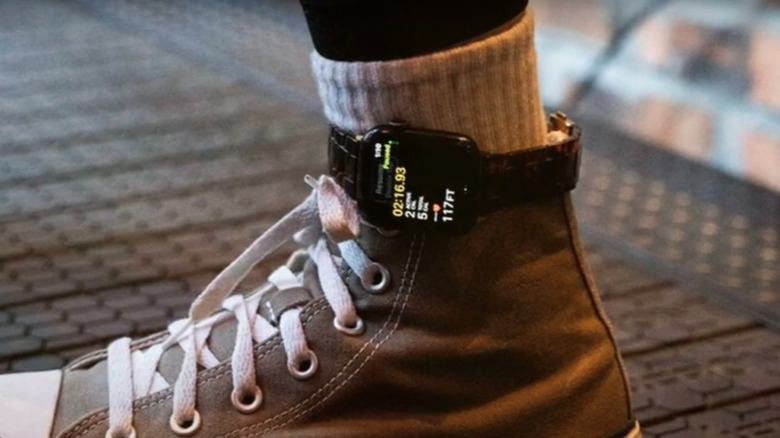How To Use An Apple Watch To Track Steps While On A Walking Pad
Walking pads have become a popular way for many people with sedentary jobs to get in a few extra steps during their workday. These minimalist treadmills fit under your desk, making it possible to get some exercise in without leaving your workspace and keyboard behind. That's why many consider them to be an underrated high-tech smart office product, especially for the fitness-minded. While there's no question that walking pads make it much easier to stay active at your desk, if you want to track your steps with your Apple Watch, you might find that the numbers aren't adding up. That's because the Apple Watch counts steps based on how often you move your wrist.
If you're typing on your computer or resting your arms on your desk, your Apple Watch may not recognize that you're actually walking and assume you're standing still, even if your feet are busy moving beneath your desk. The good news is there's a workaround that'll allow you to track your steps more accurately while on a walking pad: simply wear your Apple Watch on your ankle instead of your wrist. This might sound like a strange fix, but placing the watch on your ankle can help the device track your steps more accurately than when your arms are in a stationary position. If you log lots of hours on a walking pad while working, this simple change can make a big difference in your step count at the end of the day.
Wearing your Apple Watch on your ankle can give you more accurate step counts
In most situations, tracking your steps using an Apple Watch is pretty straightforward. Once the watch is strapped onto your wrist and you're moving naturally, it automatically counts your steps throughout the day. Your Apple Watch uses a combination of its accelerometer and gyroscope to track the number of steps you take, with the movement of your wrist playing a role in how it counts your steps. When your hands are busy typing or resting, which is often the case if you use a walking pad at work, the watch won't detect much movement, even if you're actually walking the whole time.
Shifting your watch from your wrist to your ankle can help you bypass this limitation because foot motion still produces a consistent impact pattern that the accelerometer can pick up, allowing it to track your steps more reliably. In gym circles and on social media, this ankle placement has become known as the "Apple Watch hack," with users on TikTok, Reddit, and other platforms saying this simple adjustment results in better step counts when you're doing an activity that doesn't involve moving your wrists. While these reports are anecdotal and Apple hasn't officially endorsed the trend, if you've found your Apple Watch undercounts your steps when you're using a walking pad, wearing it on your ankle could be a simple way to get more accurate results.
What are the pros and cons of wearing your Apple Watch on your ankle?
Whether you're trying to track steps while on a walking pad or pushing a shopping cart, strapping your Apple Watch to your ankle can make a real difference in your step count. This increased accuracy might help you use your Apple Watch to track calories burned more accurately, giving you a more accurate picture of your daily activity and overall fitness. You may also find ankle placement more comfortable if you have small wrists, tattoos that interfere with its sensors, or if your Apple Watch's band irritates your skin. As useful as wearing your Apple Watch on your ankle can be, it does come with a few downsides.
Apple designed its watch to track step counts using your wrists, and its algorithms are designed for that. If you move your Apple Watch to your ankle, you might notice readings for things like calorie burn, distance, or active minutes are unreliable or inconsistent. However, some users who've tested the ankle placement say they haven't noticed much of a difference. Wearing your Apple Watch on your ankle can look a bit hard and make it harder to check notifications and use features like Apple Pay. But if you're only strapping it to your ankle while walking at home, those trade-offs don't really matter. Plus, you get the added benefit of improving your step count accuracy.


